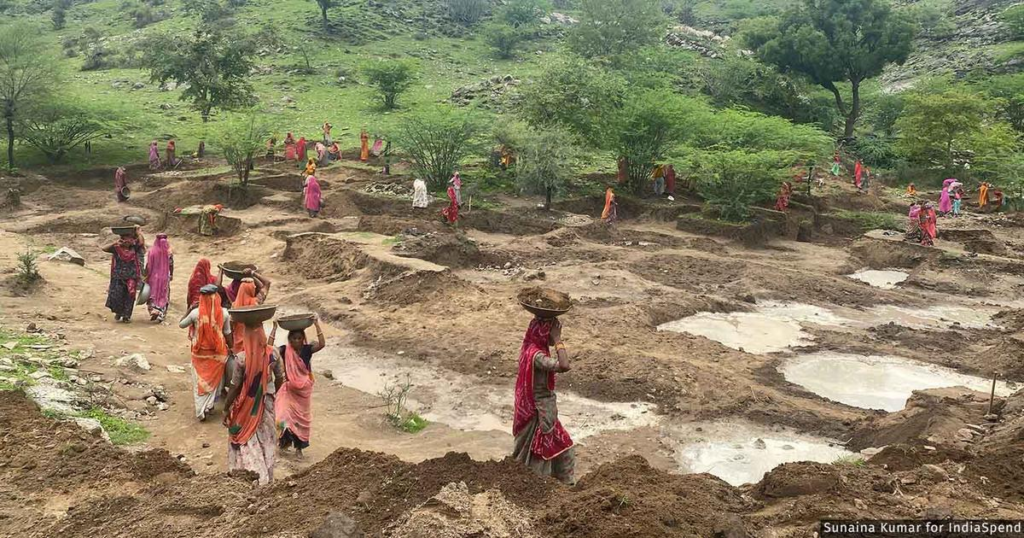In a world where gender equality is increasingly recognized as a fundamental principle, understanding the dynamics of female labour force participation is paramount. In India, the Mahatma Gandhi National Rural Employment Guarantee Act (MGNREGA) stands as a pioneering initiative aimed at providing livelihood security by guaranteeing at least 100 days of wage employment in rural areas. However, the effectiveness of MGNREGA in bolstering female labour force participation and its impact on wage rates warrants critical examination.

Wage Rates under MGNREGA:
MGNREGA mandates that the wages paid to workers, irrespective of gender, should not be less than the statutory minimum wage. This ensures a basic level of income security for the rural workforce. However, concerns have been raised regarding the adequacy of these wage rates, particularly in light of inflation and rising living costs. While the Act seeks to provide a safety net for the rural poor, the real wages may not always align with the prevailing economic realities, leading to debates about the efficacy of MGNREGA in lifting households out of poverty.
Female Labor Force Participation:
Female labour force participation in India has historically been lower than that of males, reflecting deep-rooted socio-cultural norms and structural barriers. MGNREGA, with its emphasis on providing employment opportunities at the grassroots level, holds the potential to empower women economically and socially. By guaranteeing work and ensuring equal wages, MGNREGA seeks to dismantle gender disparities in the labour market and enhance female agency.
However, the ground reality presents a nuanced picture. Despite the provisions of MGNREGA, women continue to face impediments in accessing and retaining employment opportunities. Deeply entrenched patriarchal attitudes, limited access to education and training, and household responsibilities often restrict women’s participation in the workforce. Moreover, the nature of work provided under MGNREGA, which predominantly revolves around manual labour in infrastructure projects, may not always align with the skill sets and preferences of female workers.
Impact of Wage Rates on Female Labor Force Participation:
The wage rates offered under MGNREGA play a crucial role in determining the attractiveness of the scheme for female workers. Adequate wages not only provide economic security but also serve as a powerful incentive for women to participate in the workforce. However, if the wage rates fail to meet the minimum threshold for sustenance, they may act as a deterrent, particularly for women from marginalised communities who are already grappling with multiple socio-economic challenges.
Moreover, the gender wage gap persists within the framework of MGNREGA, with women often receiving lower wages than their male counterparts for similar work. This perpetuates inequalities and undermines the principle of equal pay for equal work. Addressing this disparity requires concerted efforts to enforce compliance with wage regulations and promote gender-sensitive wage-setting mechanisms.
The intersection of wage rates under MGNREGA and female labour force participation underscores the intricate linkages between economic policies and gender dynamics. While MGNREGA has undoubtedly expanded employment opportunities and provided a social safety net for millions of rural households, its impact on female labour force participation remains a subject of scrutiny.
To harness the full potential of MGNREGA in promoting gender equality and women’s empowerment, a multi-faceted approach is imperative. This entails not only revisiting wage rates to ensure adequacy and equity but also addressing the underlying structural barriers that inhibit women’s participation in the workforce. Investments in education, skill development, childcare facilities, and awareness-raising campaigns are indispensable for creating an enabling environment where women can exercise their right to work freely and contribute meaningfully to the economy.
In essence, the success of MGNREGA in advancing gender equality hinges on its ability to transcend mere rhetoric and translate into tangible outcomes that uplift the lives of rural women. As India marches towards a more inclusive and equitable future, harnessing the potential of its female workforce is not just a matter of economic imperative but a moral imperative rooted in principles of justice and dignity for all.






